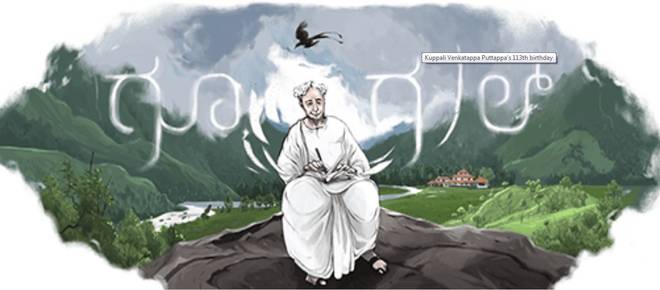The epic poem, Sri Ramayana Darshanam, for which Kuvempu was awarded the Jnanpith is a verse rendering of the Ramayana, and remains his most enduring work.
The renaissance of Kannada literature on the national stage was heralded by the publication of Kuvempu’s Sri Ramayana Darshanam, which was awarded the Jnanpith Award, half a century ago. Google is honouring the contribution of one of Karnataka’s foremost man of letters by dedicating a doodle to the winner of the first Kannada Jnanpith on the occasion of his 113th birth anniversary. Incidentally, it is also the golden jubilee of the author’s novel Malegalalli Madumagalu.
Kuppali Venkatappa Puttappa, who is better known by the pseudonym Kuvempu, was born on December 29, 1904 in Shimoga district. He was initially home-schooled, but was later enrolled at the Anglo-Vernacular school in Tirthahalli following the death of his father when he was 12. After completing his primary education he moved to Mysore to attend the Wesleyan High School, and later the Maharaja’s College of Mysore from where he graduated, majoring in Kannada and English.
The bilingual education he received played an important part in his literary evolution. Kuvempu’s first work Beginner’s Muse, a collection of poems, was penned in English. However, his dalliance with the English language was short-lived.
Kuvempu took up a lecturer post at his alma mater Maharaja’s College in 1929 and also taught at the Central College in Bangalore before his second stint at Maharaja’s University, where he would go on to become the Principal. In the intervening years, he was at the vanguard of educational reforms in the State, and was a proponent of making Kannada the medium of instruction in institutions in the State.
Kuvempu was appointed the Vice-Chancellor of Mysore University in 1956. His reputation in academic circles closely mirrors the development of his literary career. The rigours of life in academia only fuelled his literary output. He published short stories, plays, two novels, and 25 collections of poetry during the course of his career.
He was staunchly opposed to casteism and many of his works explore political themes. Kuvempu also advocated gender equality and was opposed to superstition. The large body of work he left behind spans many genres, but he is primarily known for his poetry, the subject of his verses often being derived from nature. In the doodle, Kuvempu is seen surrounded by nature, the muse for many of his poems.
The epic poem, Sri Ramayana Darshanam, for which Kuvempu was awarded the Jnanpith is a verse rendering of the Ramayana, and remains his most enduring work. It also marks the beginning of Mahakavya, an era where contemporary writers took to telling epic tales in verse, adapting the stories of yore into modern settings, and in the idiom of the day.
Recognition and accolades started pouring in soon after. Following independence, and the reorganisation of States on linguistic lines, Kuvempu was conferred honorific of Rashtrakavi (national poet) by the Karnataka government in 1958. He is also the author of Jaya Bharata Jananiya Tanujate, which was adopted as the State anthem of Karnataka in 2004.
Kuvempu was awarded the Padma Vibhushan in 1988. His contribution to Kannada literature has been lauded by peers and has influenced a generation of writers including U.R. Ananthamurthy. He passed away in November, 1994.
source: http://www.thehindu.com / The Hindu / Home> Sci-Tech> Internet / by Rohan Abraham / December 29th, 2017
